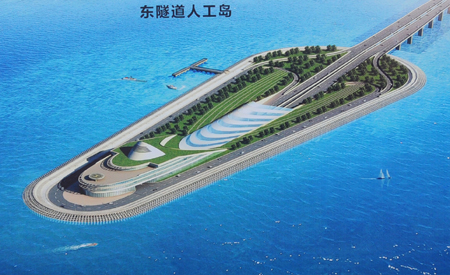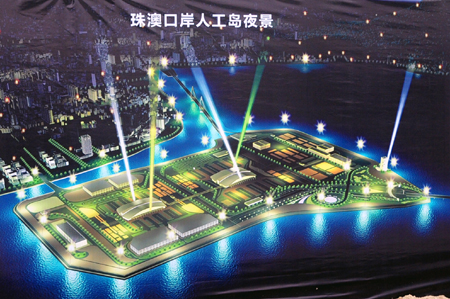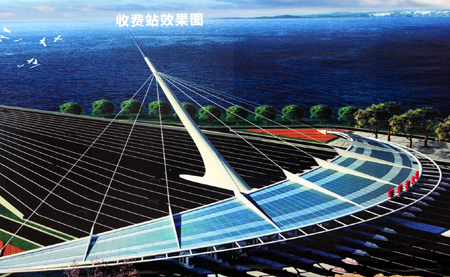Economy
HK-Zhuhai-Macao bridge begins construction
(Xinhua)
Updated: 2009-12-16 00:08
 |
Large Medium Small |
|
An architectural rendering shows a full view of the Hong Kong-Zhuhai-Macao bridge. [Xinhua] |
|
|
|
An architectural rendering shows a proposed toll gate.[Xinhua] |
ZHUHAI, Guangdong: Construction of the world's longest cross-sea bridge linking China's southern economic hub of Guangdong Province to Hong Kong and Macao began Tuesday, a move widely expected to bring economic ties closer.
Starting from the Lantau Island in Hong Kong, the Y-shaped Hong Kong-Zhuhai-Macao bridge will have a total length of almost 50 km, of which about 35 km will be built over the sea, making it the longest cross-sea bridge in the world, said Zhu Yongling, an official in charge of the project construction.
It will be built according to the six-lane expressway standard with a vehicle speed limit of 100 km per hour.
"It is designed with a service life of 120 years. It can withstand the impact of a strong wind with a speed of 51 meters per second, or equal to a maximum Beaufort scale 16 (184 to 201 km per hour)," Zhu said.
"It can also resist the impact of 8-magnitude earthquake and a 300,000-tonne vessel," he said.
The entire project was estimated to cost almost 73 billion yuan (10.7 billion U.S. dollars), which would be shared by authorities on the mainland, and in Hong Kong and Macao, he said.
During construction, they would take into consideration the protection of the ocean environment and marine life, such as white dolphins, he said.
"We will control the construction noise and turbidity of seawater, and prevent oil pollution," he said.
The construction would take about six years, he said.
On completion, it would take about half an hour to travel from Zhuhai or Macao on the west bank of the Pearl River to Hong Kong on the east bank, compared with the current three hours, he said.
CLOSER TIES
Chinese Vice Premier Li Keqiang attended the inauguration ceremony in Zhuhai, Guangdong, and launched the project Tuesday, expressing hopes that the bridge could bring the mainland, Hong Kong and Macao closer.
"The construction of the bridge is a milestone event," he said at the ceremony, five days ahead of the 10th anniversary of Macao's return to Chinese rule.
"It is a move for Hong Kong, Macao and the Pear River Delta region to cope with global economic downturn, boost investment and inspire people," he said.
"Meanwhile, it can also further increase the links and promote economic cooperation between Hong Kong and Macao, and between the mainland and Hong Kong and Macao," he said.
"It is of great significance to maintain the long-term prosperity and stability in Hong Kong and Macao, and enhance overall competitiveness in the region," he said.
Li also urged construction authorities to work with a strong sense of responsibility and sense of mission, and build a landmark in the region and a model of cooperation between the mainland and Hong Kong and Macao in the field of infrastructure construction.
Donald Tsang Yam-kuen, chief executive of the Hong Kong Special Administrative Region (SAR), Edmund Ho Hau Wah, chief executive of the Macao SAR, and Chui Sai On, the incoming Macao SAR chief executive, also attended the inauguration ceremony.
During a meeting with the three officials, Li said he hoped the two SARs could further enhance cooperation with Guangdong to seek mutual benefit and common development by drawing on one another's advantages.
Li vowed all-out efforts of the central government to continue to support the Hong Kong and Macao SAR chief executives and governments to govern by law.
He urged the SAR governments to closely watch changes in the global economic and financial situation, consolidate the stabilizing trend in the regions' economies, and promote the long-term prosperity and economic development of Hong Kong and Macao.
The central government is developing the Pearl River Delta, the former vanguard of China's economic reform, into a new test field for the country as it works to deepen economic reform and open itself wider to the outside world.
Under a 2008-2020 development plan for the southern Pearl River Delta released in January by the National Development and Reform Commission (NDRC), the delta, together with Hong Kong and Macao, will be forged into "a globally competitive" and "vigorous area in the Asia-Pacific region" by 2020.
The area includes the cities of Guangzhou, Shenzhen, Zhuhai, Foshan, Jiangmen, Dongguan, Zhongshan, Huizhou and Zhaoqing in southern Guangdong Province.
 |
|
An architectural rendering shows a proposed island as part of Hong Kong-Zhuhai-Macao bridge.[Xinhua] |
 |
|
An architectural rendering shows the Hong Kong-Zhuhai-Macao bridge. [CFP] |
 |
|
An architectural rendering showsthe Hong Kong-Zhuhai-Macao bridge. [Xinhua] |
|
 |
|
An architectural rendering shows the Hong Kong-Zhuhai-Macao bridge. [Xinhua] |
The NDRC plan maps out comprehensive development for the delta area, including industrial development, technology innovation, environmental protection and social welfare. The plan also includes cooperation with Hong Kong and Macao.
For a long period, Hong Kong and Macao developed their own industries with different competitive edges. Hong Kong is known as an international center of trade, shipping, travel, finance and information, while Macao boasts its industries of gambling, manufacturing, financial insurance and architecture.
The bridge could promote industrial competitiveness in the region, consolidate economic ties, and speed up construction of an integrated regional market, said Prof. Yuan Chiping, with the Hong Kong, Macao, Zhuhai Delta Studies Center of the Guangzhou-based Zhongshan University.
"The region is expected to become of the most dynamic economic zones in the world with the bridge," he said.














